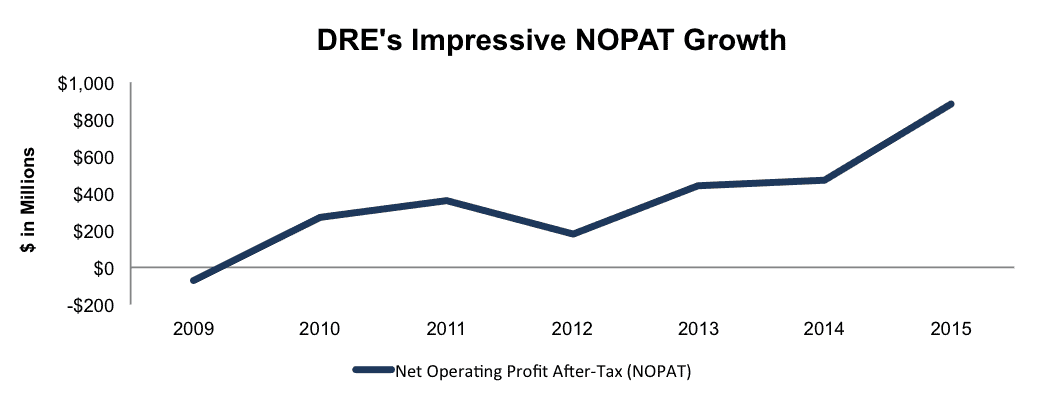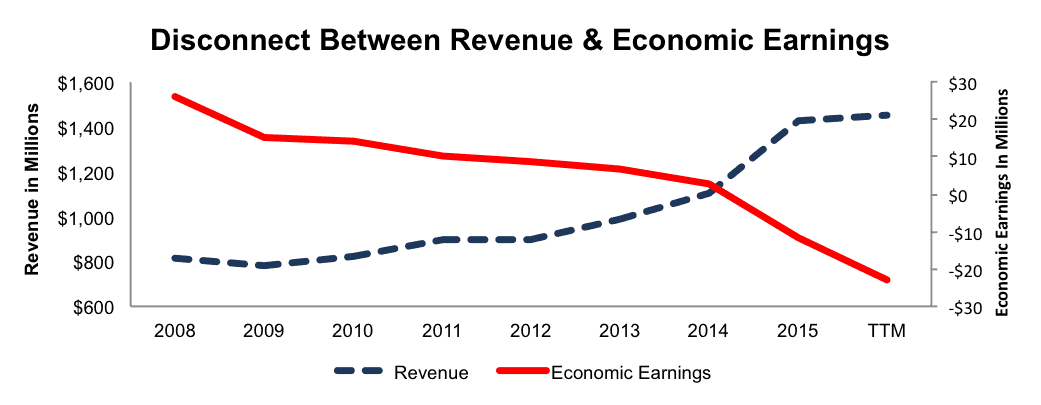New Stocks On Most Attractive And Most Dangerous Lists: June 2016
Our Most Attractive Stocks (+0.9%) underperformed the S&P 500 (+2.2%) last month. Most Attractive Large Cap stock United Therapeutics (UTHR) gained 10% and Most Attractive Small Cap stock American Axle & Manufacturing (AXL) was up 12%. Overall, 17 out of the 40 Most Attractive stocks outperformed the S&P 500 in May and 24 had positive returns.
Our Most Dangerous Stocks (+2.4%) underperformed the S&P 500 (+2.2%) last month. Most Dangerous Large Cap stock Norwegian Cruise Line (NCLH) fell by 6% and Most Dangerous Small Cap Stock Marchex Inc. (MCHX) fell by 18%. Overall, 17 out of the 40 Most Dangerous stocks outperformed the S&P 500 in May.
The successes of the Most Attractive and Most Dangerous stocks highlight the value of our forensic accounting. Being a true value investor is an increasingly difficult, if not impossible, task considering the amount of data contained in the ever-longer annual reports. By analyzing key details in these SEC filings, our research protects investors’ portfolios and allows our clients to execute value-investing strategies with more confidence and integrity.
19 new stocks make our Most Attractive list this month and 28 new stocks fall onto the Most Dangerous list this month. June’s Most Attractive and Most Dangerous stocks were made available to members on June 2, 2016.
Our Most Attractive stocks have high and rising return on invested capital (ROIC) and low price to economic book value ratios. Most Dangerous stocks have misleading earnings and long growth appreciation periods implied by their market valuations.
Most Attractive Stock Feature for June: Duke Realty (DRE: $24/share)
Duke Realty (DRE), commercial real estate investor, is one of the additions to our Most Attractive stocks for June.
Duke Realty has recovered from the 2008/2009 economic crisis quite impressively. Since 2009, DRE has grown after-tax profit (NOPAT) from -$74 million to $884 million in 2015. Over the past five years, DRE has grown NOPAT by 26% compounded annually. See Figure 1.
Figure 1: DRE NOPAT Growth Since 2009

Sources: New Constructs, LLC and company filings
Duke Realty’s return on invested capital (ROIC) has improved from -1% in 2009 to 12% over the last twelve months. Further highlighting the profitability of DRE’s business over the long-term, 2009 was the only year in which the company earned a negative ROIC.
Impacts Of Footnotes Adjustments And Forensic Accounting
In order to derive the true recurring cash flows, an accurate invested capital, and an accurate shareholder value, we made the following adjustments to Duke Realty’s 2015 10-K:
Income Statement: we made $288 million of adjustments, with a net effect of removing $272 million in non-operating expenses (29% of revenue). We removed $8 million in non-operating income and $280 million in non-operating expenses. You can see all the adjustments made to DRE’s income statement here.
Balance Sheet: we made $521 million of adjustments to calculate invested capital with a net increase of $483 million. One of the largest adjustments was $110 million due to operating leases. This adjustment represented 2% of reported net assets. You can see all the adjustments made to DRE’s balance sheet here.
Valuation: we made $3.5 billion of adjustments with a net effect of decreasing shareholder value by $3.5 billion. There were no adjustments that increased shareholder value. The largest adjustment was the removal of $3.5 billion in adjusted total debt, which includes $110 million in off-balance sheet debt. This adjustment represents 42% of Duke Realty’s market cap. Despite the decrease in shareholder value, DRE remains undervalued.
Current Valuation Provides Upside Opportunity
Duke Realty’s share price has increased 80% over the past five years. Despite this impressive performance, opportunity for upside still exists, as shares remain undervalued. At its current price of $24/share, DRE has a price-to-economic book value (PEBV) of 0.9. This ratio means that the market expects DRE’s NOPAT to permanently decline by 10%. This expectation seems low given the NOPAT growth DRE has achieved since 2009. If the company can grow NOPAT by just 2% compounded annually for the next decade, the stock is worth $31/share today – a 29% upside.
Most Dangerous Stock Feature: Matthews International (MATW: $55/share)
Matthews International (MATW), a memorialization and industrial product provider, is one of the additions to our Most Dangerous stocks for June.
Matthews International has grown revenue by 8% compounded annually from 2008-2015. Over this time, Matthews’ economic earnings, the true cash flows, have fallen from $26 million to -$12 million. Over the most recent twelve months, economic earnings have fallen further to -$23 million. Figure 2 has the details.
Figure 2: Revenue Doesn’t Equate To Profits

Sources: New Constructs, LLC and company filings
Apart from growing losses, Matthews’ ROIC has fallen from 12% in 2008 to only 5% over the last twelve months. Additionally, over the past five years, Matthews has burned through a cumulative -$802 million in free cash flow.
Forensic Accounting Reveals Overstated EPS
In order to derive the true recurring cash flows, an accurate invested capital, and a real shareholder value, we made the following adjustments to Matthews International’s 2015 10-K:
Income Statement: we made $133 million of adjustments with a net impact of removing $46 million in non-operating expenses (3% of revenue). We removed $89 million in non-operating expensesand $44 million in non-operating income. You can see all the adjustments made to MATW’s income statement here.
Balance Sheet: we made $422 million of adjustments to calculate invested capital with a net increase of $56 million. The largest adjustment was $150 million related to other comprehensive income. This adjustment represented 8% of reported net assets. You can see all the adjustments made to MATW’s balance sheet here.
Valuation: we made $1.2 billion of adjustments with a net effect of decreasing shareholder value by $1.2 billion. One adjustment increased shareholder value by $13 million. All other adjustments decreased shareholder value. Apart from debt, the largest adjustment was the removal of $124 million in net deferred tax liabilities. This adjustment represents 7% of Matthews’ market cap.
Valuation Implies Unrealistic Growth
Despite the issues above, the market has priced MATW for significant profit growth in the future. To justify its current price of $55/share, MATW must grow NOPAT by 11% compounded annually for the next 14 years. This expectation is nearly quadruple the NOPAT CAGR achieved by Matthews since 2008 and seems too optimistic.
Even if Matthews can grow NOPAT by just 5% compounded annually for the next decade, the stock is still worth only $25/share today – a 55% downside.
Disclosure: David Trainer and Kyle Guske II receive no compensation to write about any specific stock, style, or theme.



